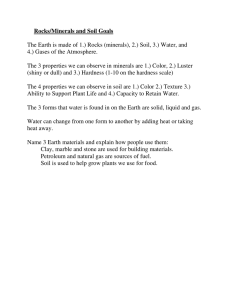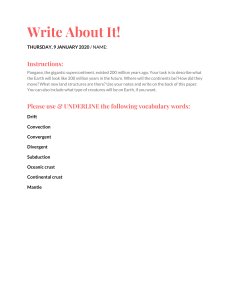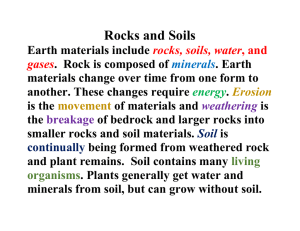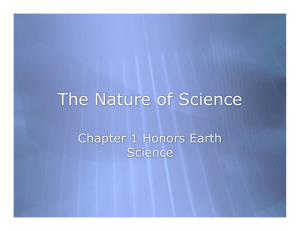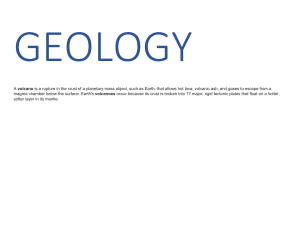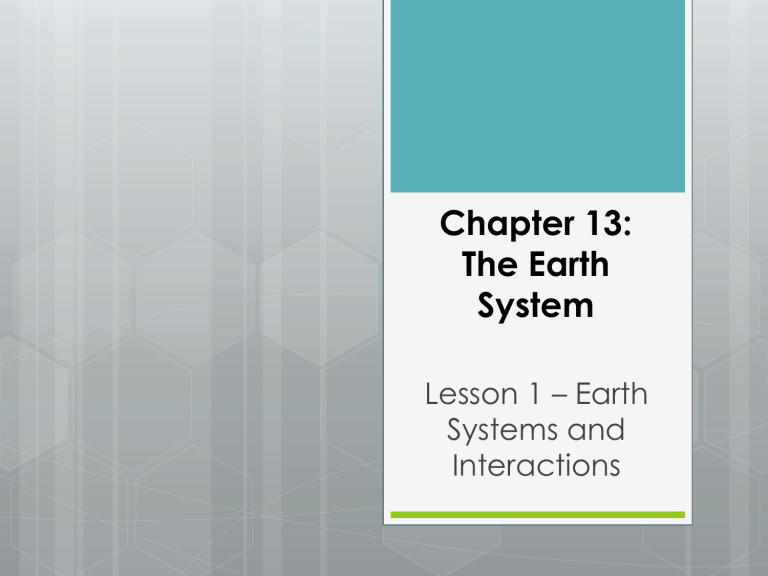
Chapter 13: The Earth System Lesson 1 – Earth Systems and Interactions Earth Systems 4 smaller systems make up the Earth systems: Hydrosphere Atmosphere Biosphere Geosphere Geosphere Hydrosphere Atmosphere • Ozone layer protects organisms • Plants- CO2 • Animals- O2 • Wind causes weathering and erosion • Volcanic eruptions • Water cycle influences weather and climate • Global warming melts ice caps • All organisms need water • Sea levels affect habitats • Water and ice cause weathering, erosion and deposition. • Hurricanes and tsunamis change coastal landforms Geosphere Biosphere Hydrosphere Interactions • The geosphere provides nutrients • Organisms cause weathering, erosion and fossil fuel formation The Carbon Cycle Carbon is an essential element of life Carbon is found in all of the Earth systems Carbon Reservoirs Carbon (Billions of tons) Form Atmosphere 750 CO2 Gas Biosphere 3000 Organic molecules Hydrosphere 40,000 Dissolved CO2 gas Geosphere (crust and upper mantle) 750,000 Minerals and rocks Geosphere (lower mantle) 750,000 + Minerals and rocks The Phosphorus Cycle Phosphorus is not found in nature as an element, it forms compounds with oxygen called phosphates (PO4) Phosphorus, like carbon, is an essential element for life. Phosphorus does not enter the atmosphere under normal conditions. Phosphorus originates in the geosphere within rocks and minerals and as phosphates in soil. Phosphorus enters the hydrosphere when phosphates dissolve into water and move through the water cycle. Phosphorus enters the biosphere when plants absorb phosphates from soil or water. Animals obtain phosphorus when they eat plants. Phosphorus returns to the soil as part of animal waste or as part of decomposing organisms. Chapter 13: The Earth System Lesson 2 – The Geosphere Materials in the Geosphere A thin layer of soil covers much of Earth’s land Soil is on top of a layer of broken rock material Under the broken rock are layers of mostly solid rock surrounding a hot metallic centre. The basic building blocks for soil, rocks and metals are minerals. There are about 3800 known minerals Minerals The 5 characteristics of minerals: Naturally occurring Inorganic Solid Crystal structure Definite chemical composition Mineral Properties Each mineral has unique physical properties which can be used to identify them. Luster – some minerals reflect a lot of light (metallic minerals), others are dull (non-metallic minerals) Streak – colour of a minerals powder Hardness – How easily a mineral is scratched by other minerals or objects. Hardness can be measured using the Mohs scale. Cleavage – the tendency of minerals to break along smooth, flat surfaces. Fracture – the tendency of minerals to break along irregular surfaces Mohs Scale Soil Soil is the loose, weathered material in which plants grow. Soil has a layered structure which forms as rock is slowly transformed into soil. Soil formation begins when rocks weather into sediment. Water dissolves minerals which become part of the developing soil. Organisms add nutrients from waste and their decaying bodies. The organic matter makes soil more fertile and gives it a dark colour. A-horizon B-horizon C-horizon A-horizon This is the top layer, where you are most likely to find plants and other organisms. It contains the most organic matter, so it is usually darker than the other layers. B-horizon This layer is mostly made of clay, iron minerals and some organic matter, which has been washed down to this horizon by rainwater. C-horizon The parent material from which the upper soil layers developed. It consists primarily of large rocks. A-horizon B-horizon C-horizon Structure of the Geosphere The geosphere is composed of different layers which formed many years ago when Earth was much hotter than it is now. When Earth was mostly liquid, gravity pulled denser materials towards the centre. This is why Earth’s layers have different compositions and different densities. Earth’s Crust The crust is the thin outer layer of the geosphere. It is made of brittle rocks composed of minerals. There are two types of crust: oceanic and continental. Oceanic crust is under oceans. It is about 7km thick and made of dense igneous rocks (basalt and gabbro which contain iron and magnesium). Oceanic crust is denser than continental crust. Continental crust makes up Earth’s continents. It is much thicker than oceanic crust (40-70km). It is made of igneous, sedimentary and metamorphic rocks. These rocks are rich in silicon and oxygen which have low densities. Earth’s Mantle Beneath Earth’s crust is the mantle The mantle is the thick, rocky middle layer of the geosphere. Much of the mantle is made of the rock peridotite, which contains more iron and magnesium than the crust and is therefore denser. Rocks in the uppermost mantle are more brittle than the rest of the mantle and are similar to the rocks in the crust. Because of this the crust and uppermost mantle are sometimes described as one layer – The lithosphere. Earth’s Mantle Most of the rock below the lithosphere is solid, but high temperatures make the rock soft enough to flow. At a depth of about 100km is an especially soft layer of the mantle. This weak, partially melted layer of the mantle is called the asthenosphere. Earth’s Core The dense, metallic centre of Earth is called the core. The core is made mostly of iron and nickel There are 2 layers: outer core and inner core Outer core – This layer is liquid due to the high temperatures near the centre of Earth. As Earth spins on its axis the molten iron flows, producing Earth’s magnetic field. Inner core – This is a sphere of solid metal with a temperature of about 4300°C. The high pressure from the masses of Earth’s layers compress the inner core, making it solid.
